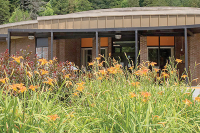A honey of a locust
Every few years, there will be a bumper crop of long flat strap-shaped honey locust pods, many up to two inches wide and a foot or more in length. Hanging in abundance along roadsides, they always bring back childhood memories.
My roaming buddies and I used to gather them in the Virginia piedmont pastures and woodlands from the thorny trees and eat the sugary pulp. The young greenish-brown pods that appear from mid-summer into early fall yield a sweet treat, whereas the older twisted maroon-colored pods that fall in winter tend to be bitter — although it’s possible, now and again, to find a few older ones that contain good stuff.
Unfortunately, the young pods are virtually inaccessible, being protected as they are by the tree’s vicious needles. I’ve heard that a squirrel being chased by a dog will avoid flight up a honey locust tree because of these three-pronged barbs, which form a thick cluster around the area where the first set of limbs grow as well as along the limbs. The larger spines can be up to 12 inches in length.
My friends and I were often foolish fellows, but we never so crazy as to attempt to climb a honey locust tree. We would occasionally spot pod clusters that could be reached from the ground or an adjacent tree or building. Usually, however, we attached a rope to a rock and tossed it over a limb and then stripped off the fruits by pulling the rope back and forth.
I suppose the last time I harvested honey locust that way was in the mid-1950s. These days, I like to pick up a fallen pod and keep it on my desk as a momento of days gone by.
Related Items
Recently, I decided to read up on honey locust (Gledistia triacanthos), which grows typically to about 75 feet beside roads and fields, but sometimes in the forest. Here are some things about the tree that I stumbled upon:
The “Knowing Your Trees” volume issued by the American Forestry Association in 1937 advised that, “While belonging to the pea family, botanists do not classify it with ... black locust (Robinia pseudoacacia), with which it is often confused . . . In 1753 Linnaeus named the genus ‘Gledistia’ in honor of Johann Gottlieb Gleditsch, then professor of botany at Berlin. The forked spines are recognized in ‘triacanthos,’ meaning ‘three-thorned’ ... The numerous, brown, oval bean-like seeds enclosed within the pods are separated by a sweet and succulent pulp. They are eaten by cattle, deer, rabbits, foxes and squirrels, which scatter the seeds over large areas ... The species matures at about 120 years, but may live longer.”’
The “Common Forest Trees of North Carolina” (1977) pamphlet issued by the N.C. Department of Natural Resources stated that the wood is only “moderately decay-resistant” and, in this regard, “should not be confused with the very durable wood of the black locust.”
In Fall Wildflowers of the Blue Ridge and Great Smoky Mountains (1987) Oscar Gupton and Fred Swope noted that, “Honey locust, also known by the names sweet locust and honeyshuck, is very much an ornamental species by way of its large and colorful fruits and the finely divided foliage that produces an effect of green, lacelike mist. The formidable thorniness has a beauty of its own, but it can also present formidable problems. There is, however, a [cultivated] form of the tree that is completely free of thorns.”
My favorite tree-information book is A Natural History of Trees of Eastern and Central North America (1950) by Donald Culross Peattie, who made his home in the Tryon, N.C., area during the period before and after World War II. We’ll give Peattie the last word in this honey locust symposium
“Down in Florida this tree is still sometimes called by the obsolete name of Confederate pintree, because its formidable spines were used to pin together the tattered uniforms of the southern hosts in the war of the Blue and Gray. Honeyshucks is the name used in some parts of Virginia, and very appropriate it is on account of the sweet pods eagerly eaten by cattle and sometimes by nibbling country boys ... The word locust, of course, is a transportation to the New World tree of an Old World name. When Saint John went into the wilderness he lived on ‘honey and locusts,’ says the Bible, and by later transposition the name of the noisy insect became attached to the rattling, edible pods of carob (Ceratonia siliqua), often called St. John’s-bread.
“Not unnaturally, a sweet-tasting pod on an American tree received the name ‘locust.’ While the thorns of the black locust are superficial and easily picked off, those of the honey locust arise from the wood and cannot by any means be pulled out ... In the days when southern mountain folk had to use the natural resources at hand, they employed these thorns in carding wool, and for pinning up the mouths of wool sacks.”
George Ellison wrote the biographical introductions for the reissues of two Appalachian classics: Horace Kephart’s Our Southern Highlanders and James Mooney’s History, Myths, and Sacred Formulas of the Cherokees. In June 2005, a selection of his Back Then columns was published by The History Press in Charleston as Mountain Passages: Natural and Cultural History of Western North Carolina and the Great Smoky Mountains. Readers can contact him at P.O. Box 1262, Bryson City, N.C., 28713, or at This email address is being protected from spambots. You need JavaScript enabled to view it..









